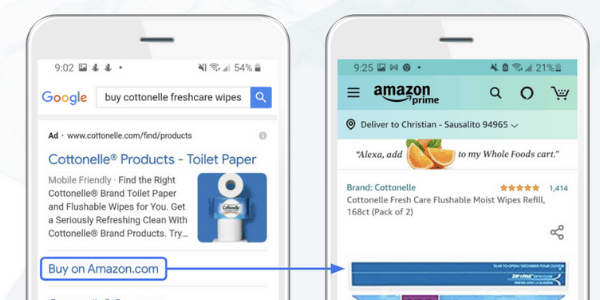
In marketing, share of voice has traditionally been defined as a brand’s advertising investment divided by the total advertising investment in your category. For example, if your brand spends $100 million and the total category advertising spending is $1 billion, then you have a 10% share of voice.
The thinking here is that advertising spending = results, so if you outspend your competitors, then you should generate the most results. That may have worked pre-Internet because brands did have a lot of power when it came to the conversation and being the loudest voice in the room, but today, CPG digital marketing best practices dictate that growing share of voice requires more than just throwing money at the problem.
Today, a better definition for share of voice would be less connected to spend and more about who can dominate the conversation across the digital channels that matter most. After all, with the right data, strategy, and execution, savvy CPG digital marketing can help your brand leapfrog category leaders who might spend significantly more on advertising.
What is Share of Voice?
Share of voice, commonly referred to as SOV, is a measure of how much your organization owns in its specified market in comparison to various competitors. The more you post ideal content such as new blogs, guest articles, and thought leadership posts, the more you own the market and dominate the industry-related conversation.
Using CPG digital marketing to grow your online share of voice
For CPG digital marketing practitioners, the three biggest online conversations to master are:
- The first page of results on search engines
- On social media apps
- Within online stores
Growing your share of voice on search engines

Web visitors from search engines tend to be the most significant single traffic type to most websites. Thus, ensuring that your brand has a strong presence/share of voice on Search Engine Results Pages (SERP) is incredibly important for today’s CPGs.
While organic search traffic is highly prized and free, — although best-in-class SEO programs can be pricey — at some point, it will be limited. Also, the organic search rankings of important keywords can always be shifting, and there are stories of big algorithmic changes made by engines that can have devastating results on a brand’s organic share of voice.
Paid Search is a good way for CPG digital marketing groups to complement the organic search traffic already coming to their sites. For example, if an exhaustive effort to rank organically high on valuable keywords isn’t working, Paid Search ads can be used strategically to ensure visibility.
Another example where Paid Search can be used to grow share of voice is when a CPG brand releases a new product — especially in a new category which will take time to build organic rankings. While the initial SEO efforts are running, Paid Search can be used to supplement traffic until the organic traffic picks up.
When using Paid Search this way, the key is to buy towards value versus just buying the most expensive placements. Yes, you could set your ads to always target your ads at the absolute top of the page but you’ll burn through your budget quickly. Try targeting different, less costly placements so you can appear more often in consumer search results.
Google has offered the impression share metric for many years which “is the percentage of impressions that your ads receive compared to the total number of impressions that your ads could get.” While this can let a CPG marketer know the share of advertising impressions they have on the search engine, it doesn’t measure organic + paid search visibility.
However, there are a number of third-party tools that can approximate organic search share. By putting those two metrics together, a marketer can begin to benchmark and holistically optimize their SEO and Paid Search efforts to improve their total search engine share of voice.
Growing your share of voice in social media

With so many consumers on social media, maintaining a high share of voice is key to getting noticed, but that can be tough in what has become a rather crowded environment. It’s hard for CPG brands to compete with baby pics, celebrity announcements, and political conversations.
Just like the search engine arena, there are both organic ways for CPG marketers to drive awareness and engage consumers as well as paid advertising. The strategy is somewhat similar: benchmark your organic share of voice and then compliment it wherever needed with paid. However, the main difference versus Paid Search is that Social Advertising has many different ad formats and types that can be used to engage consumers.
CPGs have traditionally invested heavily in television advertising, so they can repurpose those assets into video ads for social. If the product is very visually appealing image ads and carousel ads make a lot of sense. And today’s CPGs are starting to explore more options for mobile apps so app install ads can be used to drive downloads.
If executed correctly — and with engaging creative — social advertising can absolutely build share of voice to help CPG brands dominate the social conversation happening within their sub-category.
Growing your share of voice on ecommerce websites
Although CPGs knew years ago that the shift to online grocery was inevitable, the pandemic has fast-forwarded the trend by years. Nearly four out of five (78.7%) consumers reported in a recent survey that they have shopped online for groceries since the COVID-19 outbreak, up 39% from before the pandemic. 56.7% also said that they shop for groceries online more often now than before the pandemic.
More evidence of this online CPG acceleration was that Target’s digital sales increased by 275% in April, with some weeks topping seven times the typical volume. And Walmart’s grocery app was the top download among all retail apps downloads in April up 460% vs. its daily average in January 2020.
On big online retailers such as Amazon.com, Walmart.com, and Target.com, consumers primarily find brands via the sites’ search engines. Just like with Paid Search, within the ecommerce SERPs there are organic rankings and paid ads to help CPG brands drive traffic to their product detail pages. Paid ads on these store websites — called Ecommerce Channel Ads — are quickly becoming one of the key channels when digital marketing for CPG.
Just as with Search and Social, the key to applying Ecommerce Channel Ads strategically is to first benchmark your organic presence. If a product is already ranking pretty high on the first page of ecommerce SERPs, then it may not need that extra boost from paid ads. However, if a product isn’t ranking very high — or is simply so new that it hasn’t had a chance to be ranked — then using paid ads holistically to guarantee visibility is a good tactic.
One of the best ways to grow share of voice with Ecommerce Channel Ads is to target the actual product detail pages of your competitors’ top products. Some CPG marketers are unaware that this is an option and may not have considered this form of competitive judo. If the best analogy for share of voice is like dominating the conversation, placing ads on your rival’s product pages might be comparable to politely butting in when your competitor is chatting with consumers.
CPG digital marketing to grow your share of voice requires the right technology
When thinking about digital marketing for CPG, the three biggest battlefronts are search engines, social media, and within ecommerce websites. Mastering these channels — especially using paid ads to complement your organic presence — is a great way to grow your share of voice and stay relevant with consumers.
Skai’s suite of marketing technologies helps advertisers to drive performance, stay productive, and stay sharp with the campaign insights to enable data-driven decision-making.
Our platforms include:
- Skai Search – Achieve next-level performance with the award-winning, industry leader in SEM
- Skai Social – Engage social customers while achieving your branding and performance goals
- Skai Ecommerce – Create, manage, forecast, and optimize Ecommerce Channel Ad campaigns at scale
For more information, contact us today to set up a brief demo and see these best-in-class tools in action.






